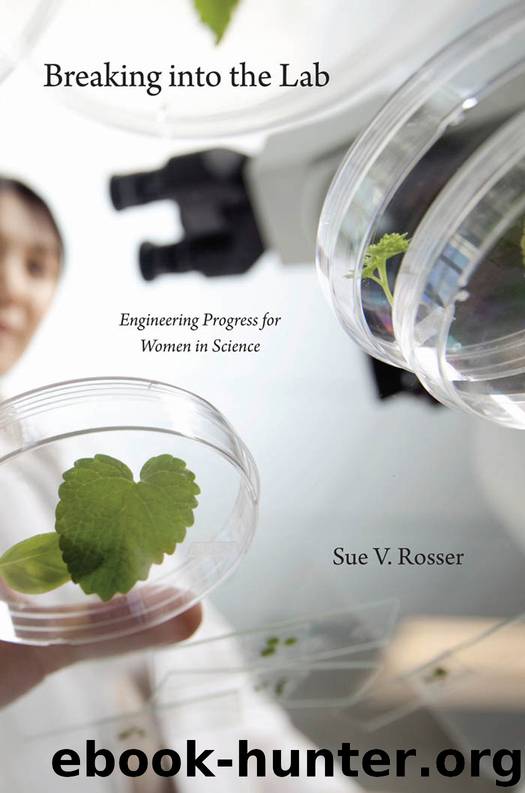Breaking into the Lab by Rosser Sue V.;

Author:Rosser, Sue V.;
Language: eng
Format: epub
Publisher: NYU Press
Published: 2012-04-19T04:00:00+00:00
Significance of Mentors
Although Jane Ramirez indicated that she did not have a particular mentor, she recognized the importance of women being nominated for awards and prizes. Such nominations and recognitions not only become critical for advancement, but serve as one of the more important ways for a mentor to smooth the way for mentees to advance. A mentor or network of powerful mentors may help facilitate this movement back and forth among the different sectors, recommending the mentee for key positions and advising her when not to accept certain opportunities. Particularly for a woman scientist, a powerful male mentor may be critical for helping her to reach the top. Although senior women may face tensions over whether or not to seek leadership roles, as a senior woman scientist noted, they may ultimately encounter a glass ceiling:
Yes, I think that senior women scientists and engineers may experience a “glass ceiling” that precludes their advancing in their careers beyond a certain level. I think that this is due to sexism, purely and simply, and that this sexism is fueled by men’s fear of competition.
A senior woman director of a professional society suggests the importance of mentors in deciding who breaks the ceiling to attain the very top leadership roles:
Yes, the glass executive ceiling. At the very top, only a few women get chosen and these because they have mentors and supporters—the extreme case being Condi Rice and her patron George W. Bush.
In an earlier article (Rosser 2007), I discussed the relative similarity or uniformity of the men’s curriculum vitae (CV) compared to those of women faculty, which became evident to me after serving in administrative positions as dean and now provost that enable me to see hundreds of curriculum vitae each year. In that article focused on tenure and promotion, I wrote the following:
Of course, the CVs of men varied in their content in terms of research and teaching focus and included some variety and variance in numbers and quality of publications, teaching evaluations, and service. Although an occasional outlier among the male CVs stood out as especially strong or unusually weak, most of the men fit a bell curve without too much variation from the mean.
In contrast, the CVs of the women showed much more variation and could be described most accurately as a bimodal distribution. Many women substantially outperformed both their male and female peers in at least one, and often all areas of teaching, research, and service. Other women remained at the other tail of the distribution, lagging considerably behind both their male and female colleagues. (Rosser 2007, 191–92)
After discussing the impact on chances for promotion and tenure, I went on to speculate as to why the men appeared to be getting and responding fairly uniformly to the messages about expectations for promotion and tenure, while the women did not. After eliminating differences in background training upon hiring, start-up packages, and discrimination, I posited mentoring as a possible reason for the gender differences:
Differences in mentoring received by men and
Download
This site does not store any files on its server. We only index and link to content provided by other sites. Please contact the content providers to delete copyright contents if any and email us, we'll remove relevant links or contents immediately.
Enlightenment Now: The Case for Reason, Science, Humanism, and Progress by Steven Pinker(6871)
A Journey Through Charms and Defence Against the Dark Arts (Harry Potter: A Journey Through…) by Pottermore Publishing(4725)
The Immortal Life of Henrietta Lacks by Rebecca Skloot(4254)
A Journey Through Divination and Astronomy by Publishing Pottermore(4248)
Elon Musk by Ashlee Vance(3854)
Origin Story: A Big History of Everything by David Christian(3472)
COSMOS by Carl Sagan(3346)
Alchemy and Alchemists by C. J. S. Thompson(3294)
Enlightenment Now by Steven Pinker(3271)
Shadow of Night by Deborah Harkness(3173)
Inferior by Angela Saini(3150)
A Mind For Numbers: How to Excel at Math and Science (Even If You Flunked Algebra) by Barbara Oakley(3103)
Bad Pharma by Ben Goldacre(3095)
Origin Story by David Christian(2991)
Signature in the Cell: DNA and the Evidence for Intelligent Design by Stephen C. Meyer(2875)
The Code Book by Simon Singh(2856)
The Elements by Theodore Gray(2851)
A Brief History of Time by Stephen Hawking(2819)
A Journey Through Potions and Herbology (A Journey Through…) by Pottermore Publishing(2772)
